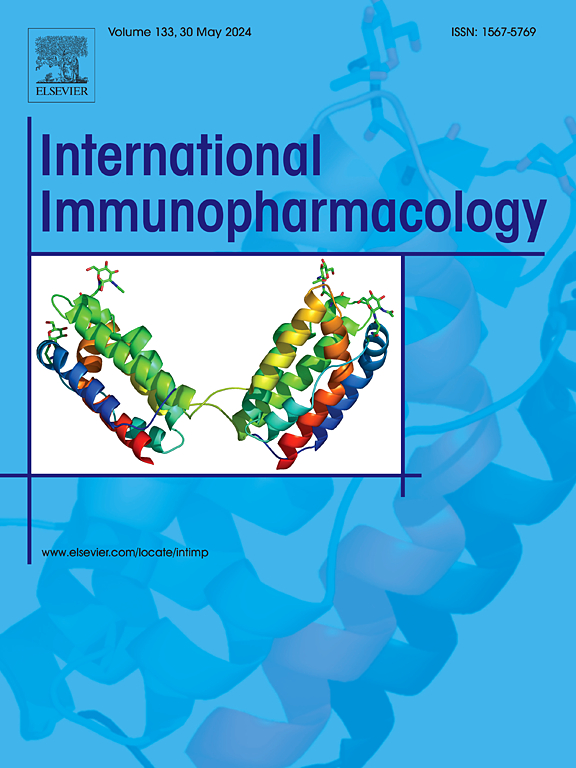木犀草素通过 JAK2/STAT3 途径调节线粒体动力学和巨噬细胞极化,从而改善牙周炎。
IF 4.8
2区 医学
Q2 IMMUNOLOGY
引用次数: 0
摘要
背景:牙周病(PD)是一种影响口腔和全身健康的慢性炎症。木犀草素(LUT)是一种天然类黄酮,具有抗炎作用,但其在牙周病中的治疗潜力和机制仍不清楚:本研究旨在探讨木犀草素对口腔干燥症的影响,重点关注其对线粒体动力学、巨噬细胞极化和 JAK2/STAT3 信号通路的影响:方法:采用网络药理学分析、体内和体外实验相结合的方法。使用结扎诱导的大鼠脊髓灰质炎模型和 LPS 刺激的 THP-1 衍生巨噬细胞评估了 LUT 的疗效。主要评估包括骨质流失的显微 CT、巨噬细胞极化的流式细胞术和通路分析的 Western 印迹:结果:LUT 能明显减少肺泡骨质流失,并增强 M2 巨噬细胞极化,CD206 和 Arg1 表达的增加表明了这一点。此外,它还通过减少 ROS 和恢复膜电位、减少线粒体裂变和促进线粒体融合来改善线粒体功能。从机制上讲,LUT 可抑制 JAK2/STAT3 磷酸化,促进抗炎作用:这些研究结果表明,LUT 可通过调节线粒体动力学、促进 M2 巨噬细胞极化和抑制 JAK2/STAT3 信号通路来改善牙周炎症和骨质流失。这凸显了LUT是一种治疗牙周病的多靶点候选药物。本文章由计算机程序翻译,如有差异,请以英文原文为准。
Luteolin ameliorates periodontitis by modulating mitochondrial dynamics and macrophage polarization via the JAK2/STAT3 pathway
Background
Periodontal disease (PD) is a chronic inflammatory condition affecting oral and systemic health. Luteolin (LUT), a natural flavonoid, has shown anti-inflammatory effects, but its therapeutic potential and mechanisms in PD remain unclear.
Objective
This study aimed to investigate the effects of LUT on PD, focusing on its impact on mitochondrial dynamics, macrophage polarization, and the JAK2/STAT3 signaling pathway.
Methods
A combination of network pharmacology analysis and in vivo and in vitro experiments was employed. The efficacy of LUT was evaluated using a ligature-induced rat PD model and LPS-stimulated THP-1-derived macrophages. Key assessments included micro-CT for bone loss, flow cytometry for macrophage polarization, and Western blot for pathway analysis.
Results
LUT significantly reduced alveolar bone loss and enhanced M2 macrophage polarization, as indicated by increased CD206 and Arg1 expression. Additionally, it improved mitochondrial function by reducing ROS and restoring membrane potential, decreasing mitochondrial fission, and promoting mitochondrial fusion. Mechanistically, LUT inhibited JAK2/STAT3 phosphorylation, promoting anti-inflammatory effects.
Conclusion
These findings suggest that LUT ameliorates periodontal inflammation and bone loss by modulating mitochondrial dynamics, promoting M2 macrophage polarization, and suppressing the JAK2/STAT3 signaling pathway. This highlights LUT as a promising multitarget candidate for PD treatment.
求助全文
通过发布文献求助,成功后即可免费获取论文全文。
去求助
来源期刊
CiteScore
8.40
自引率
3.60%
发文量
935
审稿时长
53 days
期刊介绍:
International Immunopharmacology is the primary vehicle for the publication of original research papers pertinent to the overlapping areas of immunology, pharmacology, cytokine biology, immunotherapy, immunopathology and immunotoxicology. Review articles that encompass these subjects are also welcome.
The subject material appropriate for submission includes:
• Clinical studies employing immunotherapy of any type including the use of: bacterial and chemical agents; thymic hormones, interferon, lymphokines, etc., in transplantation and diseases such as cancer, immunodeficiency, chronic infection and allergic, inflammatory or autoimmune disorders.
• Studies on the mechanisms of action of these agents for specific parameters of immune competence as well as the overall clinical state.
• Pre-clinical animal studies and in vitro studies on mechanisms of action with immunopotentiators, immunomodulators, immunoadjuvants and other pharmacological agents active on cells participating in immune or allergic responses.
• Pharmacological compounds, microbial products and toxicological agents that affect the lymphoid system, and their mechanisms of action.
• Agents that activate genes or modify transcription and translation within the immune response.
• Substances activated, generated, or released through immunologic or related pathways that are pharmacologically active.
• Production, function and regulation of cytokines and their receptors.
• Classical pharmacological studies on the effects of chemokines and bioactive factors released during immunological reactions.

 求助内容:
求助内容: 应助结果提醒方式:
应助结果提醒方式:


